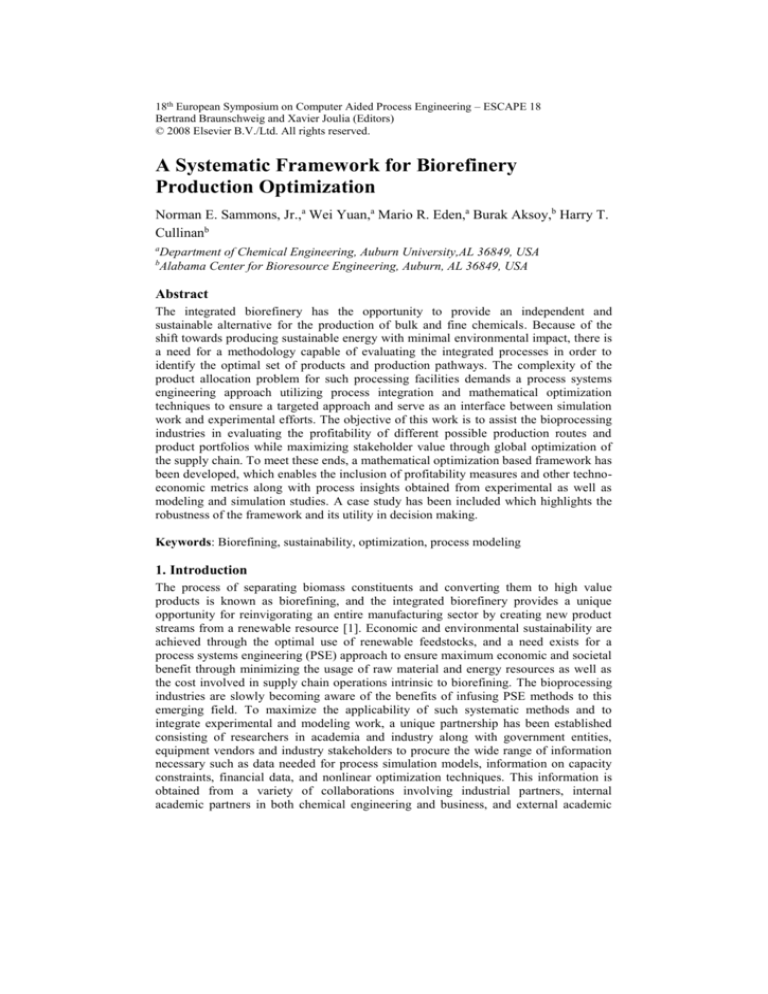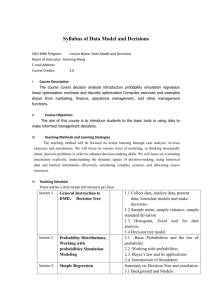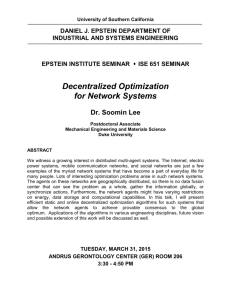
18th European Symposium on Computer Aided Process Engineering – ESCAPE 18
Bertrand Braunschweig and Xavier Joulia (Editors)
© 2008 Elsevier B.V./Ltd. All rights reserved.
A Systematic Framework for Biorefinery
Production Optimization
Norman E. Sammons, Jr.,a Wei Yuan,a Mario R. Eden,a Burak Aksoy,b Harry T.
Cullinanb
a
b
Department of Chemical Engineering, Auburn University,AL 36849, USA
Alabama Center for Bioresource Engineering, Auburn, AL 36849, USA
Abstract
The integrated biorefinery has the opportunity to provide an independent and
sustainable alternative for the production of bulk and fine chemicals. Because of the
shift towards producing sustainable energy with minimal environmental impact, there is
a need for a methodology capable of evaluating the integrated processes in order to
identify the optimal set of products and production pathways. The complexity of the
product allocation problem for such processing facilities demands a process systems
engineering approach utilizing process integration and mathematical optimization
techniques to ensure a targeted approach and serve as an interface between simulation
work and experimental efforts. The objective of this work is to assist the bioprocessing
industries in evaluating the profitability of different possible production routes and
product portfolios while maximizing stakeholder value through global optimization of
the supply chain. To meet these ends, a mathematical optimization based framework has
been developed, which enables the inclusion of profitability measures and other technoeconomic metrics along with process insights obtained from experimental as well as
modeling and simulation studies. A case study has been included which highlights the
robustness of the framework and its utility in decision making.
Keywords: Biorefining, sustainability, optimization, process modeling
1. Introduction
The process of separating biomass constituents and converting them to high value
products is known as biorefining, and the integrated biorefinery provides a unique
opportunity for reinvigorating an entire manufacturing sector by creating new product
streams from a renewable resource [1]. Economic and environmental sustainability are
achieved through the optimal use of renewable feedstocks, and a need exists for a
process systems engineering (PSE) approach to ensure maximum economic and societal
benefit through minimizing the usage of raw material and energy resources as well as
the cost involved in supply chain operations intrinsic to biorefining. The bioprocessing
industries are slowly becoming aware of the benefits of infusing PSE methods to this
emerging field. To maximize the applicability of such systematic methods and to
integrate experimental and modeling work, a unique partnership has been established
consisting of researchers in academia and industry along with government entities,
equipment vendors and industry stakeholders to procure the wide range of information
necessary such as data needed for process simulation models, information on capacity
constraints, financial data, and nonlinear optimization techniques. This information is
obtained from a variety of collaborations involving industrial partners, internal
academic partners in both chemical engineering and business, and external academic
2
N.E. Sammons et al.
sources. This ensures that the data used in the decision making process is realistic and
that the research addresses problems of industrial and regulatory interest. The overall
goal of this work is to develop a system that will enable decision makers to evaluate
different production pathways in biorefining in order to maximize value while
measuring and minimizing environmental impact.
2. Methodology for Integrating Modeling and Experiments
In biorefining, the large number of possible process configurations and products results
in a highly complex problem that cannot be solved using simple heuristics or rules of
thumb. Business decision as well as policy makers must be able to strategically plan for
and react to changes in market prices and environmental regulations by identifying the
optimal product distribution and process configuration. Thus, it is necessary to develop
a framework which includes environmental metrics, profitability measures, and other
techno-economic metrics. Such a framework should enable policy and business decision
makers to answer a number of important questions like:
For a given set of product prices, what should the process configuration be, i.e. what
products should be produced in what amounts?
For a given product portfolio, how can process integration methods be utilized to
optimize the production routes leading to the lowest environmental impact?
What are the discrete product prices that result in switching between different
production schemes, i.e. what market developments or legislative strategies are
required to make a certain product attractive?
What are the ramifications of changes in supply chain conditions on the optimal
process configuration?
In the following sections, the developed framework for answering these questions is
presented along with a discussion of some preliminary results.
The introduction of PSE methods into biorefining research provides a systematic
framework capable of seamlessly interfacing results generated in simulation studies as
well as experimental work. Such a framework is imperative when attempting to
combine knowledge and information from a variety of research areas and disciplines.
The objective of this approach is to create a library of rigorous simulation models for
the processing routes along with a database of corresponding performance metrics.
Wherever possible, experimental data is used to validate the performance of the
simulation models, and for processes that commercial software packages are incapable
of describing adequately, the performance metrics are initially based on experimental
results until a satisfactory model has been developed.
Figure 1 shows a schematic representation of the strategy employed for identification of
characteristic performance metrics of the individual subprocesses. The simulation
models for each process are developed by extracting knowledge on yield, conversion,
and energy usage from empirical as well as experimental data. If a given process
requires the use of a solvent, molecular design techniques like CAMD and property
clustering techniques are employed to identify alternative solvents that minimize
environmental and safety concerns [2, 3].
A Systematic Framework for Biorefinery Production Optimization
Published Data
3
Semi-empirical Data
Data and Knowledge Extraction
No
Performance Validated?
Base Case Simulation Models
Aspen Plus, Hysys, Pro/II
Yes
INTERACTIVE PROCESS & MOLECULAR DESIGN
Solvent-based Process?
Yes
Process Synthesis
Desired Properties of
Solvents
Design
Targets
Molecular Design
PARIS, ProCAMD,
Databases
No
Alternative Solvents
Process Integration
Pinch Analysis, Thermal Management &
Resource Conservation Strategies
Optimized Simulation Models
Minimum Utility Usage, Maximum Resource Utilization,
Reduced Environmental Impact
Economic Data
Cost Estimation Software & References,
Vendor Data
Model Library & Performance Metrics Database
Relative Economic Potential
Relative Environmental Impact
Environmental Impact Data
PARIS, ProCAMD, Databases
Superstructure of Processing Routes
Tree Structure Incorporating All Optimized Models
Figure 1 – Strategy for identification of performance metrics.
Process integration techniques are then used to optimize the simulation models. This is
an integral step in the model development as it ensures optimal utilization of biomass
and energy resources. Finally, the optimized models are used to generate data for the
economic as well as environmental performance metrics. The estimation of
environmental performance is achieved through the use of the US-EPA Waste
Reduction (WAR) algorithm [4]. It should be noted, that only the economic and
environmental performance metrics are incorporated in the solution framework
described below, thus decoupling the complex models from the decision making
process. This approach allows for continuously updating the models as new data
becomes available without having to change the selection methodology. Similarly, if
new processes are to be included for evaluation, an additional set of metrics are simply
added to the solution framework, thus making it robust and flexible.
3. Generalized Biorefinery Model
A generalized biorefinery model has been used to develop the structure of the
optimization framework and is given in Figure 2. The model structure was formulated
to include a variety of basic complexities encountered in the decision making process,
e.g. whether a certain product should be sold or processed further, or which processing
route to pursue if multiple production pathways exist for a given product. The objective
function maximizing the overall profit of the biorefinery is illustrated in Equation 1.
4
N.E. Sammons et al.
Bioresource m
R 01,01
R 01,02
Product k= 1
R 02,01
R 01,04
R 01,03
Product k = 2
Product k = 3
R 02,02
TS 01
Product k = 4
R 02,03
TS02
Product k= 5
TS05
TS04
Product k = 6
TS03
TS 06
Market
Figure 2 – Generalized biorefinery model to illustrate possibilities in decision making tree.
P
Profit TSmk Cks Rmij Cmij
CmBM Rm1 j
m k
i
j
j
(1)
Using this nomenclature, the first set of terms in Eq. (1) represents the sales revenue
from the products made from each bioresource m. TSmk is a variable that denotes the
production rate of product k from bioresource m that is sold to the market. Cks is the
sales price of product k which is a scalar and is determined through a survey of
published prices and vendor quotes. The second set of terms represents the total
processing cost incurred by the pathways pursued in production. Rmij is a variable that
represents the processing rate of route ij while CmijP is a scalar that represents the cost of
processing bioresource m through route ij and is determined through simulation models
and process economics. The third set of terms represents the total cost of the biomass
resource m, and this is broken down into the scalar purchase price of bioresource m in
CmBM and the combined rate of biomass processed by the plant in Rm1j. Although both
TSmk and Rmij are variables in the optimization program, they are not independent since
the variables are related via mass balance constraints around the product points.
The model may be utilized for short-term decision making with existing equipment and
market arrangements, or long-term planning that will involve extensive capital
expenditure, market forecasts on the future prospects of targeted products, and supply
chain considerations. This generalized model, where the objective function and
constraints are linear, is easily solved using commercially available software. It should
be noted here that while earlier work such as the proposed solution by Sahinidis and
Grossman incorporate process models into the optimization problem, the proposed
framework separates the wide range of biorefining models from the optimization
portion, thus reducing the complexity of the problem for the solver while maintaining
the robustness achieved with proven optimization techniques [5].
Without including any constraints on capacity of the processing steps, the solution is a
single-product configuration in which all available biomass is converted into the most
profitable product. However, if constraints are imposed on the most profitable route, the
framework identifies the additional products and processing routes required to
maximize the overall profit, thus leading to a polygeneration facility [5]. Approximate
capacity constraints are based on a variety of sources, e.g. existing equipment, vendor
data and qualitative process information provided by academic and industrial
collaborators. In order to effectively address the strategic planning objectives of
business decision makers, it is necessary to incorporate the total capital investment as a
A Systematic Framework for Biorefinery Production Optimization
5
constraint in the formulation. The capital investment for a given unit or process can be
approximated as a function of its capacity or processing rate, and both linear and
nonlinear expressions have been successfully implemented in the framework. Inclusion
of capital cost constraints is crucial for practical application of the results, i.e. enabling
evaluation of the potential benefits to be obtained for a given maximum investment by
retrofitting an existing facility or constructing new plants.
4. Model Demonstration
Many adjustments were made to the parameters such as sales price, processing cost,
processing rate conversions, and capital investment functions, and constraints were
added on capacity as well as minimum and maximum sales quantities. These
modifications were made to determine if the code would give the product distributions
that were intuitively determined to maximize profit. In every case, the code returned the
solutions including predictable results on the product distribution as well as the
pathways necessary to manufacture the product while maximizing value.
A case study was performed on a potential biorefinery involving the conversion of
chicken litter to syngas, hydrogen, and electricity. Actual data on conversion rates were
obtained from experimental work performed by the university and affiliated agencies as
well as simulations constructed in ASPEN. Figure 3a shows the possible pathways for
production and sale of these chemicals on the commodity market. The execution of the
optimization code verified the results obtained from manual calculation; producing
syngas from chicken litter and selling it on the market would maximize profit due to the
high costs involved in converting the syngas to hydrogen or electricity. Figure 3b
illustrates the active pathway chosen by the optimization program. This simple case
study will be expanded to include a much wider range of products, production
pathways, and feedstocks in order to become a crucial decision support tool in the
emerging field of biorefining.
Bioresource m
Chicken Litter
Bioresource m
Chicken Litter
12.56 kg/s
Biomass
R 01,01
Product k = 1
Syngas
R 02,01
0
R 02,02
Product k = 2
Hydrogen
TS 02
Syngas (Conv.
Ratio 1.057:1)
Product k = 3
Electricity
TS01
TS 03
Market
(a)
0
Product k = 2
Hydrogen
0
Product k = 3
Electricity
13.28 kg/s
Syngas
0
Market (Optimal Profit = $1.922/s)
(b)
Figure 3 – Illustration of case study. (a) Unsolved decision making tree with variable
designations. (b) Solved decision making tree with flowrate values and objective function.
5. Conclusions and Future Work
A general systematic framework for optimizing product portfolio and process
configuration in integrated biorefineries has been presented. Decoupling the process
models from the decision-making framework reduces problem complexity and increases
6
N.E. Sammons et al.
robustness. The next phase of this work involves development of additional process
models for the generation of performance metrics, specifically information on
conversion, yield, and production cost for economic metrics and data to be used to
generate a measure of environmental impact. From there, process integration will be
utilized to optimize the process models by reducing energy usage, material
consumption, and waste streams.
An alternative formulation of the product allocation problem will be developed using a
combination of general disjunctive programming (GDP) with the use of genetic
algorithms (GA) as proposed by Odjo et al [7]. The current formulation of the problem
is a mixed-integer nonlinear problem (MINLP), and the use of GA and GDP has been
shown to solve nonconvex, discontinuous optimization problems more efficiently than
the iterative MILP-NLP approach used in many solver programs. The computation time
and objective values of optimal solutions between the GA-GDP solution method and the
MINLP method will be compared to determine which formulation and solution style is
more effective in solving this general problem [6].
The framework will also become a stronger financial tool through the incorporation of
various economic ideas and analyses. The use of net present value as a profitability
measure in a similar fashion to Sahinidis and Grossmann will enable the inclusion of the
cost of capital, interest expenses, depreciation, and tax consequences of pursued
decisions [5]. The development of qualitative predictive models for capital investment
and inclusion of capital amortization into the objective function will also increase the
strength of the framework. Incorporation of options theory into the framework will
allow management to develop financial strategies in response to events in the market or
legislative environment. Finally, optimization under uncertainty will be studied to
quantify the effects on process configuration resulting from minute changes in product
prices [7]. This, in combination with implementing superstructure generation
techniques, will lead to increased robustness of the methodology and thus better
recommendations [8].
References
1. Bridgwater, A.V. (2003). Renewable fuels and chemicals by thermal processing of biomass.
Chemical Engineering Journal, 91, 87-102.
2. M. R. Eden, S. B. Jørgensen, R. Gani and M. M. El-Halwagi. (2004). A novel framework for
simultaneous separation process and product design. Chemical Engineering and Processing,
43, 595-608.
3. P. M. Harper and R. Gani. (2000). A multi-step and multi-level approach for computer aided
molecular design. Computers and Chemical Engineering, 24, 677-683.
4. D. M. Young and H. Cabezas. (1999). Designing sustainable processes with simulation: the
waste reduction (WAR) algorithm. Computers and Chemical Engineering, 23, 1477-1491.
5. N. V. Sahinidis, I. E. Grossmann, R. E. Fornari and M. Chathrathi (1989). Optimization model
for long range planning in the chemical industry. Computers and Chemical Engineering, 13,
1049-1063.
6. A. Odjo, N. Sammons, A. Marcilla, M. Eden and J. Caballero. (2007). A disjunctive-genetic
programming approach to synthesis of process networks. Computers and Chemical
Engineering (in preparation).
7. I. Banerjee and M. G. Ierapetritou. (2003). Parametric process synthesis for general nonlinear
models. Computers and Chemical Engineering, 27, 1499-1512.
8. A. Chakraborty and A.A. Linninger. (2003). Plant-wide waste management 2: Decision
making under uncertainty. Industrial and Engineering Chemical Research, 42, 357-369.





